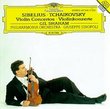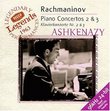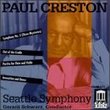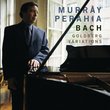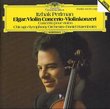| All Artists: Leopold Godowsky, Marc-Andre Hamelin Title: Godowsky: Sonata & Passacaglia Members Wishing: 1 Total Copies: 0 Label: Hyperion UK Release Date: 2/12/2002 Album Type: Import Genre: Classical Styles: Chamber Music, Forms & Genres, Sonatas, Historical Periods, Classical (c.1770-1830), Modern, 20th, & 21st Century Number of Discs: 1 SwapaCD Credits: 1 UPCs: 034571173009, 034571173009 |
Search - Leopold Godowsky, Marc-Andre Hamelin :: Godowsky: Sonata & Passacaglia
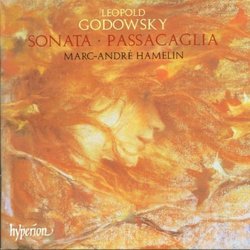 | Leopold Godowsky, Marc-Andre Hamelin Godowsky: Sonata & Passacaglia Genre: Classical Perhaps it's true that Vladimir Horowitz claimed Leopold Godowsky's 1928 Passacaglia "impossible to play." That hasn't stopped brilliant, note-gobbling supervirtuosos from taking up its uncommon cause. The work treats the ... more » |
Larger Image |
CD DetailsSynopsis
Amazon.com Perhaps it's true that Vladimir Horowitz claimed Leopold Godowsky's 1928 Passacaglia "impossible to play." That hasn't stopped brilliant, note-gobbling supervirtuosos from taking up its uncommon cause. The work treats the opening measure's of Schubert's "Unfinished" Symphony as a ground bass from which 44 variations and a gigantic fugue evolve. The increasingly elaborate, upholstered textures and harmonic purple prose often suggest Max Reger huffing and puffing his way through the Gershwin songbook, leaving little time to relax or breathe. Fortunately, Marc-André Hamelin channels his envious technique toward the most effective musical ends, taking more time with transitions than he did on his first recording of the work in 1988 and lingering just enough over lyrical passages. He unleashes intense heat in the demanding cadenza, yet keeps his scurrying fingers cool and controlled. Hamelin's unflinching proficiency and ability to handle the most taxing keyboard figurations with utter nonchalance brilliantly serve Godowsky's rambling, five-movement behemoth of a Piano Sonata. His only significant competition comes from Konstantin Scherbakov on Marco Polo, whose phrase inflections and dynamic surges tend to soften the music's grip. This is particularly telling in the Andante Cantabile, which contrasts with Hamelin's swifter, more fluid dispatch. Hamelin also keeps things moving by wisely forgoing Godowsky's superfluous repeats in the first and third movements, while Scherbakov observes them, to less convincing musical effect. It is churlish to say that no pianist need record these works again, yet future Godowsky players will have to practice to the bone in order to match, let alone surpass, Hamelin's reference versions. --Jed Distler Similarly Requested CDs
|
CD ReviewsBig ideas, big music, big performances J Scott Morrison | Middlebury VT, USA | 11/30/2002 (5 out of 5 stars) "I had to live with this CD for several months before I felt sufficiently acquainted with this previously unfamiliar music to write this review. My pleasure in this music grew with each hearing.The disc contains Godowsky's two largest pieces for piano. He is primarily remembered as a piano virtuoso and for his miniatures, particularly the transformations of Chopin's études (53 of them, based on the 26 Chopin pieces, 22 of them for left hand alone) already brilliantly recorded by Hamelin. The Sonata was composed in the decade that also brought us the Dukas 'Grande Sonate' and the Berg Op. 1 Sonata, a period that some feel was the last flowering of the Romantic piano sonata. It is huge--five movements lasting almost 50 minutes. Two very large movements, the first and fifth, surround three gentler, dreamy, graceful movements, each containing luscious Schubertian melodies. The two end movements, though, are filled with serious, lush, even hyper-romantic stuff. The first movement, in fairly strict but extended sonata form, has six distinct themes that are combined, altered, recollected (as some of them are again in the final movement), all clothed in highly chromatic harmonies. Somehow Godowsky is able to use fistfuls of notes but still keep the contrapuntal lines going perceptibly. And certainly Hamelin's ability to take dense music of this sort and make intelligible MUSIC out of it is indispensable here. The last movement, all in slow tempo, starts with a short introduction followed by a delicious Larghetto--Godowsky also arranged it for violin and piano, and later for cello and piano--not a man to let a good idea go to waste), which is then followed by a huge fugue on the notes B-A-C-H, in turn followed by a touching funeral march. The piece ends quietly with the Dies irae slowly intoned in the bass followed by a short repetition of the funeral march.The Passacaglia is based on a theme from Schubert's 'Unfinished' Symphony--not the familiar tune that every school child knows, but the tune in b minor that opens the first movement. Among pianists the piece is known as almost impossibly hard; in fact, Horowitz, after studying the piece for some time reportedly said 'It's hopeless. You need six hands to play it!' Abram Chasins, who heard Godowsky play the piece at a private gathering, wrote: "This was sheer enchantment, both the work itself and Godowsky's pianism. It had the cool, colorful clarity of a stained-glass window. Although I was greatly moved and impressed by what I heard, Godowsky's effortless mastery made me unaware of the vastness of his pianistic feat that night." (quoted in Robert Rimm's "The Composer-Pianists")And indeed, it is the case that the piece's horrendous difficulties are in the service of Godowsky's musical ideas, not simply there for show. Needless to say, Marc-André Hamelin's performances of these two pieces are ne plus ultra. One hopes, on the one hand, that these recordings might encourage others to take up these pieces, but fears, on the other, that his spectacular musicianship will intimidate other pianists. We should be glad we have these recordings.One personal note: I shall be hearing Hamelin in recital later this season. The program has not been announced. I am hoping that he includes one of these pieces on his program. But if he doesn't, at least I have this disc." Extraordinary playing; and quite a find in terms of music S. Utkus | Wilmington, DE USA | 07/11/2002 (5 out of 5 stars) "I have found this recording from Hamelin to be a most compelling disk. It is not simply Hamelin's magical pianism, but his rediscovery of the music of (yet another) neglected composer of a century ago. This is the type of music that rewards attentive listening. The music is complex and lush and romantic, but unfamiliar. The disk should be listened to, in full, at least two or three times, both to learn the scale of the work and to appreciate Hamelin's command of it.It's been said that Hamelin needs to return to the traditional repertoire, now that he has produced these outstanding recordings outside the mainstream literature. I say, au contraire! The last thing the world of recorded classical music needs is another Beethoven or Shubert sonata, another series of Bach keyboard works (sorry Murray Perahia) or yet another round of technically flawless, but risk-free Schumann or Chopin disks.The best thing to have happened to recorded classical music in the past decade is Hamelin's ceaseless promotion of this neglected literature--and of course the wonderful musicality of his own piano-playing.I can't recommend this disk too highly." An Astounding Disc! Miss Kitty Litter | Little Rock, AR | 03/24/2002 (5 out of 5 stars) "Hamelin has become quite a presence on the scene. I have most all of his recordings, and while there are a few that I received with lukewarm exuberance, this was because of the repertory......not his artistry, which shines through in everything that he essays. Godowsky is one of those composers who really deserves a great deal more listening to. I highly recommend Hamelin's beautifully recorded Godowsky/Chopin Etudes, as well. This is phenomenal playing and engineering!"
|

